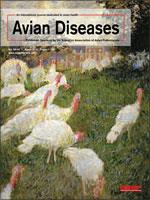Fowl cholera, caused by Pasteurella multocida, remains a major problem of poultry worldwide. In the current report, we describe an outbreak in free range organic broilers. In addition to culturing samples from dead broilers, we attempted to isolate P. multocida from feral cats trapped on the farm. The isolates were identified by PCR as P. multocida and then serotyped using the Heddleston scheme and genotyped using both a multilocus sequence typing (MLST) method and an enterobacterial repetitive intergenic consensus (ERIC)-PCR method. A total of 123 isolates of P. multocida were recovered from 12 broilers. All 123 isolates were examined by ERIC-PCR, and only one pattern was identified. A subset of seven broiler isolates were examined by MLST and all were typed as sequence type (ST) 20. A total of 28 isolates of P. multocida were recovered from 17 cats, and five ERIC-PCR genotypes were identified, with one genotype (E-1, shared by 19 isolates) being the same as the ERIC-PCR pattern associated with the broilers. One representative cat strain for each ERIC-PCR pattern was subjected to MLST. The cat isolate with the same ERIC-PCR genotype as the broiler isolates was confirmed as having the same MLST result, ST 20. The other five cat ERIC-PCR patterns were allocated to four STs: E-2 and E-5 to ST 265, E-3 to ST 30, E-4 to ST 20, and E-6 to ST 264. Both genotyping methods confirmed that isolates of P. multocida were common between the feral cats and the chickens. It was not clear whether the strain was transmitted from the cats to the chicken or whether the cats obtained the strain preying on chicken. The study has shown that cats can harbor P. multocida strains with the same genotype found in chickens affected with fowl cholera.
Epidemiología del cólera aviar en pollos orgánicos—Estudio de un caso.
El cólera aviar, causada por Pasteurella multocida, sigue siendo un problema importante en la avicultura a nivel mundial. En el presente reporte, se describe un brote en pollos de engorde de tipo orgánico. Además de cultivar muestras de pollos muertos, se intentó aislar P. multocida de gatos salvajes atrapados en la granja. Los aislamientos fueron identificados por PCR como P. multocida y luego fueron serotipificados utilizando el esquema de Heddleston y genotipificados utilizando tanto el método de tipificación por secuencia multilocus (MLST) y mediante el método del consenso intergénico repetitivo de enterobacerias (ERIC)-PCR. Se recuperaron un total de 123 aislamientos de P. multocida de 12 pollos de engorde. Todos los 123 aislamientos fueron examinados por ERIC-PCR, y se identificó un solo patrón. Un subconjunto de siete aislamientos de pollos de engorde fueron examinados por el método MLST y todos se tipificaron como secuencia tipo (ST) 20. Un total de 28 aislamientos de P. multocida se recuperaron a partir de 17 gatos, y se identificaron cinco genotipos por ERIC-PCR, con un genotipo (E-1, compartida por 19 aislamientos) siendo el mismo que el patrón de ERIC-PCR asociado con los pollos de engorde. Una cepa representativa de gato de cada patrón de ERIC-PCR fue sometida a MLST. El aislamiento de gato con el mismo genotipo ERIC-PCR del aislado de pollo de engorde se confirmó que mostraba el mismo resultado por MLST, ST 20. Los otros cinco patrones de ERIC-PCR de aislamientos de gatos fueron asignados a cuatro serotipos: E-2 y E-5 a ST 265, E-3 a ST 30, E-4 a ST 20, y E-6 a ST 264. Ambos métodos de genotipificación confirmaron que los aislamientos de P. multocida eran comunes entre los gatos silvestres y los pollos. No estuvo claro si las cepas se transmitían de los gatos al pollo, o si los gatos la obtenían mediante la predación de los pollos. El estudio ha demostrado que los gatos pueden albergar cepas de P. multocida con el mismo genotipo encontrado en los pollos afectados con





